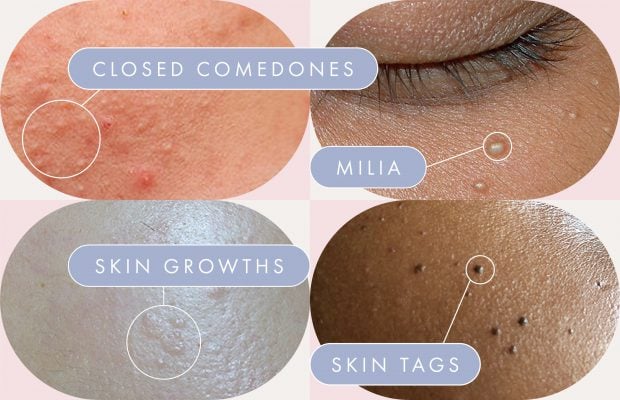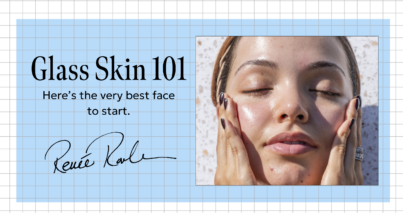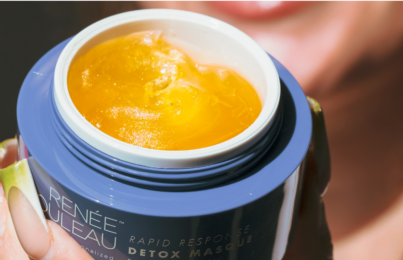Updated 06/14/22. When you see bumps appear on the skin on your face, or elsewhere on your body, it can be difficult to know what they are, simply because there are so many possibilities. But knowing what you’re dealing with is an important first step and will help you determine the best course of treatment. In this post, I will discuss the four types of skin bumps I see most often—milia, closed comedones, skin growths, and skin tags.
All these bumps share one common characteristic. They’re considered non-inflammatory lesions, which means there is generally no infection present and they usually don’t go away unless they’re removed. If a bump becomes red, inflamed, or painful, it’s likely a type of blemish. Addressing blemishes is entirely different (make sure you read my expert tips for how to get rid of a blemish as quickly as possible.)
1. Closed Comedones (Clogged Pores)
What Are Closed Comedones?
Closed comedones are non-infected, clogged pores. They appear as white bumps on the skin and are often what clients are talking about when they complain about their skin texture. Closed comedones are not as round or firm as milia, but when left untreated, they tend to hang around for long periods of time. In fact, they tend to require manual removal (but more on that in a minute).
Closed comedones can eventually turn into pustules or papules (inflammatory breakouts). This happens when oxygen can’t get into the pore, which is blocked. This creates the perfect environment for breakout-causing bacteria to thrive.
What Causes Closed Comedones?
Closed comedones are caused by a blockage of the pores. They can be triggered by a number of things, including:
- Oily Skin: Those with oily skin are naturally more prone to clogged pores (this is why exfoliation is necessary!).
- Using the Wrong Products for Your Skin Type: Usually, this happens when people use the wrong kind of moisturizers or sunscreens (particularly heavy moisturizers and water-resistant sunscreens).
- Makeup: Silicone primers, long-wear foundations, and cream blushes are the most common culprits.
- Hyperkeratosis: This is a condition that causes the outer layer of the skin to thicken and the natural exfoliation process to slow down.
How to Get Rid of Closed Comedones
- Clean Your Pores Through Manual Extraction. Ideally, you would see an experienced esthetician for a deep-pore cleansing facial with extractions. The key to successfully removing closed comedones is to pierce them with a lancet so the blockage can pop out of the skin. You can remove them at home, but it has to be done correctly. Follow these tips to safely remove closed comedones at home.
- Use Exfoliating Acids. Once your pores are clean, start using a serum with salicylic acid (BHA). Since it’s oil-soluble, it can penetrate the pore lining better than other types of acids. I highly recommend the BHA Clarifying Serum.
- Use Retinoids (Vitamin A). While I don’t recommend retinoids for inflammatory breakouts, they can be a good option for clogged pores. That’s because they speed up cell turnover, helping to keep pores clear. If you decide to go this route, read my beginner’s guide to retinoids to avoid unwanted side effects.
- Don’t Use Harsh Acne Products. Traditional breakout-focused products use strong ingredients that can leave behind loads of dry skin cells on the skin’s surface. This can trap impurities and lead to even more clogged pores over time (not good!). Swap overly drying products with gentle exfoliants and hydrating products. It will make a world of difference.
Looking for even more advice? Read my complete guide to clearing clogged pores!
2. Milia
What Are Milia?
Milia are hard, tiny bumps on the skin that appear when keratin and hardened oil get trapped below the skin’s surface. Milia are round and, because of how they look, are sometimes described as tiny “pearls.” The hardened oil gives them an off-white color, and they appear most commonly around the eyes, nose, and cheeks.
What Causes Milia?
Though the cause of milia isn’t always clear, there are a few common culprits to look out for, including:
- Long-Term Sun Exposure: In my experience, this is a common cause of milia.
- Blistering: Milia can appear after blistering from sunburns and/or other injuries and skin conditions.
- Undergoing Resurfacing Procedures: Dermabrasion and laser procedures, if performed incorrectly, can lead to milia.
- Hyperkeratosis: Milia can be common when skin is thicker and the natural exfoliation process is slowed down.
- Using Heavy Creams: If you’re seeing milia, you might want to consider your eye cream and/or moisturizer formula.
- Smoking: In my experience, smokers commonly see milia appear around their eyes. It could be that smoke is blown upwards into the eye area, causing keratinization of the skin.
How to Prevent Milia
To prevent milia from forming, you want to exfoliate regularly. This will prevent dead skin cells from trapping oil and keratin under the surface. If you don’t already exfoliate your eye area, you should start (especially since this is where milia tend to appear). The Overnight Eye Serum is formulated to gently remove buildup from around the eyes. It will also minimize dryness and fine lines and allow your eye cream to work more effectively.
How to Get Rid of Milia
If you already have milia, I have some tips for you. Because they sit under layers of hard, keratinized skin, they generally never come to a head. This means you can’t easily remove them on your own, so you should NOT try to extract them yourself. You’ll only end up damaging your skin. Instead, you need to have them removed by a licensed professional, whether a dermatologist or esthetician.
Once you find a licensed professional, they will likely remove the milia in one of two ways—manual extraction or electric cauterization (I promise this isn’t as scary as it sounds). To manually extract milia, a professional will pierce the bump with a lancet and then gently squeeze it to physically extract the hardened oil. When using an electric cauterizer, the bump will also be pierced with a small needle, but the oil and keratin will dissolve by heat. The third option for milia removal is cryotherapy, which involves freezing milia off using liquid nitrogen.
3. Skin Growths
What Are Skin Growths?
Skin growths are bumps on the face, neck, and body. They are usually benign (non-cancerous) and often begin as small flat or rough bumps. At first, these growths might be mistaken for clogged pores or breakouts, but they will never come to a head and cannot be extracted since there is no oil in them. Treating them with harsh, breakout-focused products will only result in dry, irritated skin.
They typically start to appear around age 35 and become more numerous as we age. Over time, skin growths get thicker and larger, eventually turning into skin tags or a number of other skin conditions, including seborrheic keratoses, hyperkeratosis, actinic keratoses (pre-cancerous cells), and sebaceous hyperplasia, to name a few.
As you can see in the picture above, they can either be flesh-colored or darker than your skin tone. They can also assume a number of different shapes and textures. Skin growths are generally made up of excess skin or enlarged oil glands and appear as raised bumps that are impossible to hide with makeup.
As I mentioned, most of the skin growths I discuss here are benign. I have gotten many of these and my dermatologist has always confirmed this to be true. That said, it’s very important to keep an eye out for anything new or changing. Always schedule regular skin checks with your dermatologist. When in doubt, always get it checked out!
What Causes Skin Growths?
Because “skin growths” encompass such a wide range of conditions, there are a number of potential causes, including:
- UV Damage: Consistent sun exposure can cause skin growths to form.
- Age: As we get older, our skin naturally thickens. This can lead to more bumps.
- Genetics: If you have an oily skin type, you might experience more skin growths as you get older.
- Hormones: Skin growths can appear as we go through hormonal changes.
How to Get Rid of Skin Growths
Skin growths tend to thicken over time, so it’s best to have them removed early on while they’re still manageable. Always have them checked and removed by a dermatologist. Don’t try to get rid of them yourself. In my experience, some dermatologists may not want to remove benign growths since they aren’t life-threatening. If they do remove them, you may want to have your doctor remove just one to see how your skin heals. The method of removal will depend on the type of growth, but common methods include cryotherapy, electric cauterization, and manual removal with a scalpel.
There’s one more thing I want to mention. Since many of these growths are caused by a thickening of the skin, regularly using both exfoliating acids and retinol will help minimize their formation. UV damage can also be an underlying cause, so you’ll want to wear SPF every single day!
4. Skin Tags
What Are Skin Tags?
Skin tags are one of the most common types of benign skin growths. They are soft, fleshy pieces of skin that are usually connected to the skin by a small stem. Skin tags are made up of regular fat and tissue. They can be flesh-colored or become darker than your skin, especially if there is no blood supply to the skin tag. Although they can appear anywhere, skin tags are often found around the eyes, under the arms, or on the neck.
What Causes Skin Tags?
The cause of skin tags isn’t exactly clear, but certain factors may increase the likelihood of them, including:
- Friction
- Genetics
- Hormones
- Age
- Insulin-Related Disorders
How to Get Rid of Skin Tags
Some skin tags may fall off on their own, but most of the time, they must be removed. This can be done by an esthetician or a dermatologist. The most common methods of removal for small skin tags are cryotherapy and electric cauterization. If the skin tag is larger, your dermatologist may use a local anesthetic followed by manual removal with scissors or a scalpel.
What About Other Bumps?
If the bumps on the skin on your face are red and painful, and they come and go, they are likely blemishes. If you have bumps on the backs of your arms and legs, it might be Keratosis Pilaris. Like many of the other bumps I discuss in this post, it’s caused by hyper-keratinized skin.
Next, learn how to get rid of body acne on your back and chest!
Celebrity Esthetician & Skincare Expert
As an esthetician trained in cosmetic chemistry, Renée Rouleau has spent 30 years researching skin, educating her audience, and building an award-winning line of products. Her hands-on experience as an esthetician and trusted skin care expert has created a real-world solution — products that are formulated for nine different types of skin so your face will get exactly what it needs to look and feel its best. Trusted by celebrities, editors, bloggers, and skincare obsessives around the globe, her vast real-world knowledge and constant research are why Marie Claire calls her “the most passionate skin practitioner we know.”




Comments:
I have skin growths just like the ones in the picture except one on my face is rather large and raised up quite a bit. I’m 37 now but have had it for several years and notice it more and more. Every dermatologist I’ve spoken don’t want to remove it or do anything to it since it’s on my face but that’s why I want it gone. I’ve also noticed a few spots in my bikini area that look similar and I also have skin tags in the same area. How can I get rid of those? What’s the healing process look like and for how long could I have noticeable males from where it was removed? I live in Florida and we are usually in the water in some way so the healing and how noticeable it is are very important to me.
Posted By: Jaime Richard |
Hi! For skin growths specifically consult your doc!
Posted By: Renée Rouleau |
Hi ma’am
Please explain some easy to do with open comedown
.
Posted By: Krishna |
If you have a pustular breakout or blackhead that is ready to be properly extracted check out this helpful guide! https://blog.reneerouleau.com/how-to-manually-extract-blackheads-and-clogged-pores-from-your-skin/
Posted By: Renée Rouleau |